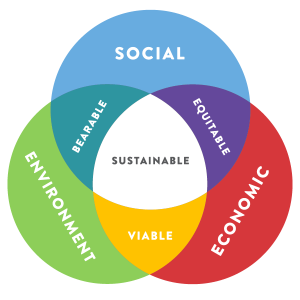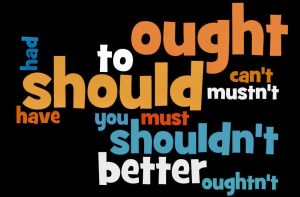 On May 19, 2016, I will be moderating two sessions at the GRI Global Conference. The first one is a session called “Forget the S-word”. The panel consists of senior professionals from the advertising, apparel and defense industries. During the prep call, we already started an animated discussion about the many issues around the S word: sustainability.
On May 19, 2016, I will be moderating two sessions at the GRI Global Conference. The first one is a session called “Forget the S-word”. The panel consists of senior professionals from the advertising, apparel and defense industries. During the prep call, we already started an animated discussion about the many issues around the S word: sustainability.
Naming
 The trouble with the S-word probably starts from a lack of a common definition. I really like the 1987 Brundtland definition: the ability to meet the needs of the present without compromising the ability of future generations to meet their own needs. But this combined notion of needs and limitations is quite conceptual. John Elkington’s Triple Bottom Line already makes it more concrete by spelling out the need for organizations to take profit, people and planet into account. Sustainability is the state achieved when the financial, social and environmental performance of an organization are well-balanced. And there are many other terms with similar intent, yet with different meanings to different people, such as Corporate Social Responsibility, Corporate Responsibility, Thriveability, and Future-Proof. Some would even put philanthropy in that same series of terms.
The trouble with the S-word probably starts from a lack of a common definition. I really like the 1987 Brundtland definition: the ability to meet the needs of the present without compromising the ability of future generations to meet their own needs. But this combined notion of needs and limitations is quite conceptual. John Elkington’s Triple Bottom Line already makes it more concrete by spelling out the need for organizations to take profit, people and planet into account. Sustainability is the state achieved when the financial, social and environmental performance of an organization are well-balanced. And there are many other terms with similar intent, yet with different meanings to different people, such as Corporate Social Responsibility, Corporate Responsibility, Thriveability, and Future-Proof. Some would even put philanthropy in that same series of terms.
Claiming
 No matter what phrase is used, it often leads to an array of claims, inside and outside of an organization. On the inside, the sustainability professionals are eager to share a list of things that “should” or “must” be done to make the organization more sustainable. On the outside, organizations make promises and share (mostly positive) outcomes of its sustainability efforts. By some stakeholders, these claims are met with enthusiasm and praise, while by others, these same claims are mistrusted or simply refuted.
No matter what phrase is used, it often leads to an array of claims, inside and outside of an organization. On the inside, the sustainability professionals are eager to share a list of things that “should” or “must” be done to make the organization more sustainable. On the outside, organizations make promises and share (mostly positive) outcomes of its sustainability efforts. By some stakeholders, these claims are met with enthusiasm and praise, while by others, these same claims are mistrusted or simply refuted.
Framing
 So how do we best use the concept of sustainability to create positive change? Inside organizations and together with the ecosystems in which they operate? Perhaps the answer lies in framing. For this, I like the first definitions provided by dictionary.com: a) to form or make, as by fitting and uniting parts together; construct; and b) to contrive, devise, or compose, as a plan, law, or poem. For sustainability to have an impact, it needs to be connected to the organization’s core goals, fitting and uniting parts together. For some organizations, this comes naturally, and sustainability will be integrated into plans quite naturally, without the need for a sustainability team. In others, there is still more work to be done by the sustainability team to frame sustainability in such a way that it becomes relevant to the business leaders, devising the right language and composing the right song sheet to get everyone aligned for positive change. The effort required will probably be a function of an organization’s industry, the cultural/national context and the conviction and focus of senior leadership.
So how do we best use the concept of sustainability to create positive change? Inside organizations and together with the ecosystems in which they operate? Perhaps the answer lies in framing. For this, I like the first definitions provided by dictionary.com: a) to form or make, as by fitting and uniting parts together; construct; and b) to contrive, devise, or compose, as a plan, law, or poem. For sustainability to have an impact, it needs to be connected to the organization’s core goals, fitting and uniting parts together. For some organizations, this comes naturally, and sustainability will be integrated into plans quite naturally, without the need for a sustainability team. In others, there is still more work to be done by the sustainability team to frame sustainability in such a way that it becomes relevant to the business leaders, devising the right language and composing the right song sheet to get everyone aligned for positive change. The effort required will probably be a function of an organization’s industry, the cultural/national context and the conviction and focus of senior leadership.
I’m looking forward to discussing this all on May 19, bright and early, during a breakfast session at the GRI conference, together with Ken Pucker, Advisory Director, Berkshire Partners: Lecturer, Boston University Questrom School of Business, Matthew Swibel, Director of Sustainability, Lockheed Martin CO and Jonathan Wise, Director, The Comms lab. I much welcome your thoughts on whether it’s time to forget the S-word!
Post script: The outcome of this panel discussion is covered in a post on the the verdict on the S-word. Want to find out more about GRI’s 2016 conference? Check out #GRI2016 on Twitter and have a look at my other posts with key takeaways from the event and integration of sustainability in education.
Written by Marjolein Baghuis (@mbaghuis) for Change in Context. To read about interesting people, book reviews and other posts about leadership, change and sustainability, please subscribe.

How do you frame the S-word in your organization to drive positive change and impact? #sustainability https://t.co/6Gx3f1FVeC
How do you name, claim and frame topics regarding sustainability? Please let me know to help me prepare for the upco…https://t.co/s6d3BuWLE9
New on my blog, in preparation of the #GRI2016 conference: Naming, claiming and framing the S-word https://t.co/6ZGQN2cAW6